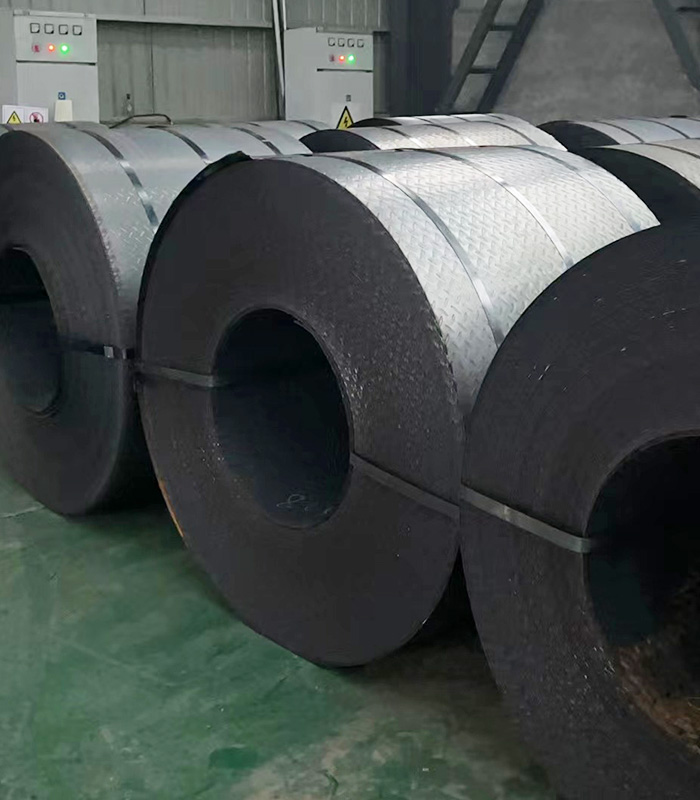Checkered Steel Coil
Home / Products / Steel Coil / Checkered Steel Coil / Checkered Steel Plate
Specifications: (1.1mm-16mm) × (1000mm-2000mm)
Material: Aluminum alloy, stainless steel, Q235B and Q345B
Description
Checkered Steel Plate is a steel plate with a raised (or recessed) pattern on the surface. The pattern is lentil-shaped, diamond-shaped, round bean-shaped, and mixed flat and round shapes. The lentil shape is the most common in the market. The pattern can be a single diamond, lentil or round bean shape, or a combination of two or more patterns to become a combined pattern plate.
Due to the diamond pattern, the risk of slipping is greatly reduced. Checkered Steel Plate is commonly used in structures such as stairs, ramps, walkways and vehicle interiors. It can also be found in construction applications.
1. Advantages: good decorative performance, non-slip.
2. Disadvantages: The production process is complicated, the price is high, and the mechanical properties are not high.
Application
Checkered Steel Plates are typically used to increase the slip resistance of the plate and to provide a decorative finish. Checkered steel plates are commonly used in the construction of flooring, stairways, and walkways, as well as in the manufacture of various industrial and transportation equipment. The pattern is typically created by pressing or rolling the steel plate through a set of dies that contain a raised pattern, or by etching the pattern into the surface using a chemical process. Checkered steel plates are available in a variety of sizes, thicknesses, and materials, including carbon steel, stainless steel, and aluminum.

The specification of the Checkered Steel Plate is expressed by the basic thickness (excluding the thickness of the raised edge), and there are 10 specifications from 2.5-8mm. The checker plate is made of No. 1-3 steel plate.
The welding seam on the upper surface of the formwork should be polished smooth before the anti-corrosion operation. In order to prevent the welding seam from breaking or the arched deformation of the steel plate due to thermal expansion and cold contraction, an expansion joint of 2 mm should be reserved. Splicing of each steel plate. A rainwater hole with a diameter of 10mm and a distance of 1m should be set at the lower part of the steel plate.
To ensure construction safety, temporary railings should be set up before the platform formwork is laid, or railings should be installed before the platform steel plate is laid. The height of the temporary railing is 1050mm, and it is erected by scaffolding with a protective bar in the middle. The surface of the protective railing should be smooth and free of burrs and structural defects.
1. After the materials are transported to the site, they should be stacked according to the specifications and installation positions, and the square wood should be padded to prevent the rain from scouring. The stacking height should not be too high to prevent deformation caused by being overweight.
2. In order to meet the requirements of the overall construction progress, the laying of the patterned steel plate is closely connected with the installation of the steel structure. After a certain stage of anti-corrosion work on the steel beam, the patterned steel plate can be laid. The laying sequence is the same as the steel beam installation sequence.
3. On the patterned steel plate, the lifting lugs are welded on the ground, and the holes to be welded on the secondary beam and the frame beam are cut with flame. The size of the opening is 6mmx12mm, and the spacing is not more than 0.5m.
Checkered plates are used in many fields, the most popular being checkered plates. New and modern uses are as architectural metal materials for wall and ceiling cladding.
It is also used as a decorative and protective panel in some designs for doors, chairs, furniture and industrial use.
Advantages
Anti-slip
The patterned surface of the patterned board increases the friction and greatly increases the safety factor when used as a substrate or deck.
Anti-bending
The checkered steel plate is made of hot rolled coil as the substrate, with high strength and toughness, strong bending resistance and long service life.
Decoration
The surface pattern of checkered steel plate has various types of patterns and has a certain ornamental appearance, and it can also be used as a decorative sheet.
The pattern of checkered steel plate mainly plays the role of anti-slip and decoration. The comprehensive effect of combined pattern plate in terms of anti-slip ability, anti-bending ability, metal saving and appearance is significantly better than that of single pattern plate.
Major Function
Application of checkered steel plate
1. Ordinary checker plates are widely used in shipbuilding, boilers, automobiles, tractors, railway cars and construction industries.
2. Floors, factory escalators, work frame pedals, ship decks, and car floors are made of steel plates with raised edges.
3. The steel plate with diamond or lentil pattern on the surface is used for workshops, large equipment or the treads of ship aisles and stairs.
| It can be used as flooring, also can be used for workshop | Checkered Steel Plate for Flooring | Checkered Steel Plate for Workshop |
| Plant escalator, work shelf tread, ship deck, car floor | Large equipment or ship walkway and stairs tread |